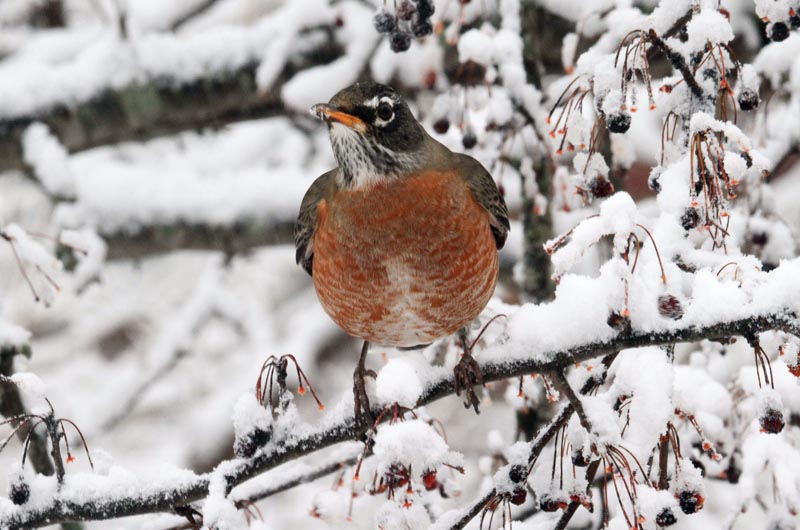Leonardo da Vinci (1452-1519) does not make it into the bird news column too often! He is obviously well known as an artist. He is not so well known as a scientist, mostly because results of his careful experiments were lost after his death and were not known for several centuries. Perhaps his most well-known engineering designs were of complex mechanisms for people to fly, modeled after his careful observations of birds in flight.
One of his many discoveries was that objects appear to be smaller when they are further away. He discovered that an object that becomes twice as far away will appear to be half as big. And he used this proportionality to provide depth of field in the biologically accurate depictions of plants and animals in his famous paintings.
We can use this principle to help determine the size of birds we observe. For example, a robin is slightly more than half the size of a crow, and that is how it will appear if they are the same distance away from you. But if the robin is about halfway to the crow, then both birds will appear to be about the same size to your eyes. If the robin is twice as far away as the crow is, the robin will appear to be about one fourth the size of the crow.
We frequently used this sort of proportionality to determine how big an unknown bird is. To make this sort of comparison, however, we must have a bird we know in the same field of view.
Bird Sightings
The most exciting bird of this week is an unusual chipping sparrow that has been visiting Lanny McDowell’s bird feeder. At first, because of its unusual coloration, nobody knew what it was, and there was considerable speculation about whether it was a hybrid of some sort. The unknown bird was the same size as a nearby chipping sparrow that was starting to develop its breeding plumage (a hopeful sign as I sit here writing this in a raging snowstorm). But it had a rufous patch behind and below the eye, where the chipping sparrow is grayish-brown. Bird guide author and artist David Sibley replied to say that this unusually plumaged chipping sparrow has a below average amount of blackish melanin pigment and an above average amount of reddish-brown melanin pigment. The latter is less common than the former, as we see many fewer unusually dark, or melanistic, individuals than we see partial albino birds with white in unusual places.
Winter finches, species that only venture south of the boreal forests of Canada when their food is scarce, are also in the news. Several redpolls have been seen on the Island. As reported last week, Charlie Kernick, Penny Townes, and Ken Magnuson all observed redpolls from Jan. 14 to Jan. 19. Allan Keith had three redpolls at his feeder on Jan. 21. And Ken Blackshaw of Nantucket had two white-winged crossbills come to his feeder on Jan. 21. I have not heard other reports, but there are undoubtedly more redpolls and crossbills around; all we need to do is find them!
Mr. Keith also reports that the phoebe that has been there since the fall was still hanging around. He also observed three red-winged blackbirds and three brown-headed cowbirds at his feeders on Jan. 20.
Laura Wainwright and Debby Farber found an American woodcock that had a bum leg along the edge of one of the Hoft farm fields (along Lambert’s Cove Road) on Jan. 22. They are here in small numbers every winter, but they are unusually hard to find. I heard them courting in January a few years ago (during what I call the winter that wasn’t, where we had cold weather for only a few days of the winter). Their courtship flights are so amazing; they are something to look forward to trying to find, but not until the temperatures rise and the snow melts.
For the second straight week, bald eagles are in the news. This time Ken Magnuson found an immature bald eagle cruising over Crackatuxet Cove on Jan. 22. Crows were chasing after it, and they looked so small compared to the eagle.
Susan Straight observed a belted kingfisher on Quitsa Pond on Jan. 24.
Lanny McDowell found a bonanza of ducks at Black Point Pond on Jan. 25. They included mallard, black duck, green-winged teal, American wigeon, gadwall, both hooded and red-breasted mergansers, and bufflehead.
Randy Rynd reports seeing her first winter flicker at her feeder on Jan. 9, and on Jan. 17 she spotted a barn owl as it flew up out of a field at Thimble Farm.
Finally, Albert Fischer heard a tufted titmouse singing in his yard on Jan. 20. Always a welcome sound; more bird song will be coming soon!
There are lots of birds around, so please get out looking for them, and be sure to report your bird sightings to birds@mvgazette.com.
Robert Culbert leads guided birding tours and is an ecological consultant living in Vineyard Haven.





Comments
Comment policy »